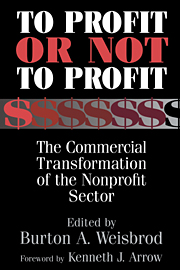Book contents
- Frontmatter
- Contents
- List of contributors
- Foreword by Kenneth J. Arrow
- Preface
- 1 The nonprofit mission and its financing: Growing links between nonprofits and the rest of the economy
- Part I Basic issues and perspective
- 2 Competition, commercialization, and the evolution of nonprofit organizational structures
- 3 Modeling the nonprofit organization as a multiproduct firm: A framework for choice
- 4 Pricing and rationing by nonprofit organizations with distributional objectives
- 5 Differential taxation of nonprofits and the commercialization of nonprofit revenues
- 6 Interdependence of commercial and donative revenues
- 7 Conversion from nonprofit to for-profit legal status: Why does it happen and should anyone care?
- Part II Industry studies
- Part III Overview, conclusions, and public-policy issues
- Appendix: IRS Forms 990 and 990-T for nonprofit organizations
- References
- Index
5 - Differential taxation of nonprofits and the commercialization of nonprofit revenues
Published online by Cambridge University Press: 30 November 2009
- Frontmatter
- Contents
- List of contributors
- Foreword by Kenneth J. Arrow
- Preface
- 1 The nonprofit mission and its financing: Growing links between nonprofits and the rest of the economy
- Part I Basic issues and perspective
- 2 Competition, commercialization, and the evolution of nonprofit organizational structures
- 3 Modeling the nonprofit organization as a multiproduct firm: A framework for choice
- 4 Pricing and rationing by nonprofit organizations with distributional objectives
- 5 Differential taxation of nonprofits and the commercialization of nonprofit revenues
- 6 Interdependence of commercial and donative revenues
- 7 Conversion from nonprofit to for-profit legal status: Why does it happen and should anyone care?
- Part II Industry studies
- Part III Overview, conclusions, and public-policy issues
- Appendix: IRS Forms 990 and 990-T for nonprofit organizations
- References
- Index
Summary
Introduction
As the nonprofit sector has grown in economic importance, so too has its reliance on income obtained from a variety of commercial activities – that is, activities involving the sale of goods or services. Because commercial income earned in the nonprofit sector is largely, if not entirely, tax exempt, this trend raises several questions: Are nonprofit organizations encouraged to pursue commercial ventures that they would otherwise eschew because the income from such activities is tax exempt? When nonprofit enterprises move into commercial markets, does their tax-exempt status give them an economic advantage? Does the prospect of earning tax-free income create incentives for nonprofit organizations to divert their energies from core philanthropic activities in order to pursue commercial ventures that are justified only because they generate revenue for the core activities? How does the differential tax treatment of nonprofits affect choices among commercial ventures?
To answer these questions, we must recognize some distinguishing attributes of nonprofits (Weisbrod 1977, 1988; Hansmann 1980; James 1983; Steinberg 1991; Eckel and Steinberg 1994). Unlike for-profit enterprises, nonprofit organizations may regard the pursuit of profit in any market as a means of achieving other “more important” organizational goals, rather than as an end in itself. In addition, donations, an important source of revenue for many nonprofits, may be sensitive to these commercial activities. For example, donors may care about how nonprofits divide their efforts between profit-making activities and producing what donors believe to be the organization's “primary” output.
- Type
- Chapter
- Information
- To Profit or Not to ProfitThe Commercial Transformation of the Nonprofit Sector, pp. 83 - 104Publisher: Cambridge University PressPrint publication year: 1998
- 3
- Cited by



